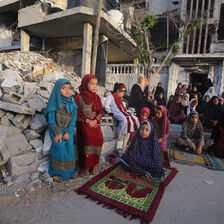The Electronic Intifada 9 January 2025

Many families are doing what they can to grow food in Gaza. (Farah Samer Zaina)
Welcome to our garden in Gaza City, where I have spent my 24 years surrounded by colors.
If you keep walking, you will see palm, orange, olive, guava and lemon trees. We shared their fruits with the whole neighborhood, bringing happiness and satisfaction over the years.
Gaza’s precious greenery is not only a source of food but a conduit for mental health recovery, a playground for growing kids, relaxation, enjoyment and much more.
If you walk the streets, you can smell flowers from gardens, and if you ask a resident of Gaza for some fruit, I bet that he or she will give you the tree.
In summer, many residents in Gaza take great pride in their gardens, even turning balconies and rooms into small ones. We used to sit in our garden among red roses with friends and loved ones eating ice cream or drinking steaming tea containing just-picked mint.
In autumn, my entire family gather to harvest olives. Laughter fills the atmosphere as we recall fun times.
Every family has its own traditions, but most in Gaza used to wake up early, pray al-Fajr or the dawn prayer, drink some hot tea with biscuits and start collecting olives. Some spread a blanket under the trees and strike the olives with a stick, causing them to fall.
“Kicking the tree with a stick would only hurt it,” my father would say. So we picked olives one by one, an exhausting process that takes up most of the day.
If you were lucky, friends would invite you to share their customs during the olive-gathering season. The kind gesture made you part of the family.
During winter, gathering for a barbecue is the most delicious tradition in Gaza. Loved ones get together to roast chicken or redmeat over coal or wood.
The meat is, then, served with mutabal – an eggplant dip.
We often dine while viewing the raindrops shining off the greenery of this part of Gaza.
In spring, our garden blooms with flowers, colors and nectar, which causes a lot of sneezing and wakes up our little armored creatures. As many as 40 turtles would walk beside us, giving life to the garden.
The garden brought me happiness as a child and as an adult. Yet both it and the rest of our home were wiped out by Israel, using D-9 bulldozers.
Destroying sources of life
More than a year ago, Israeli tanks turned our garden into a firing line and parking lot while attacking many houses, including ours. My father was injured when shrapnel penetrated a wall of our house.
We were besieged for about 25 days as Israeli soldiers burned and bombed houses and arrested and killed our neighbors.
After the troops’ withdrawal, we checked on our hiding neighbors, grieved the people who had been killed and tried to deal with the damage. The Israeli military turned our garden into a dead desert, erasing one of our sources of food among the cut-off human supplies.
The Israeli occupation forces have damaged more than 67.6 percent of Gaza’s croplands, according to the United Nations. This has led to a punishing increase in food prices, starvation, malnutrition and death.
Israeli forces wiped out croplands and resources of drinkable water in an apparent attempt to cut off the residents in Gaza’s north from any access to food and water.
In the markets in the north now, vegetables and fruits are rarely found. A kilo of onions that cost one Israeli shekel before the war is now priced at 200 shekels (almost $55).
Survival is becoming more and more of a challenge.
Growing what fruit and vegetables one can might offer the best means of survival. To do so, a consistent source of water is a necessity.
Getting water
At the beginning of the Israeli attacks, we and others were waiting for the rain to water the plants. Some would use rainwater from their gutters, refine it and store it in big water barrels.
The municipality also tried to fix some water resources to provide people with water once or twice a week.
Some individuals worked together to repair damaged wells and connect them to their houses.
Like many others, my family is determined not to be defeated
Gaza residents are now using whatever space they can find to grow plants and vegetables. Some have even covered the floors of uninhabitable apartments with soil.
As the Israeli soldiers bulldozed the wall and the gate of our garden, they pulled out the trees causing deep holes and a lot of damage. It took us about a month to restore the land to prepare it for planting.
We found many of the turtles who roamed our garden smashed or having bled to death. We buried the victims of the “turtle massacre” and searched for survivors.
Out of 40, only eight survived.
“People, animals, birds, trees, and even the stones. Nothing survived the Israelis’ destruction,” my father said.
But we were determined not to be defeated.
We started planting again so that we could regain our garden and to help our people as best we could.
We planted zucchini, onions, tomatoes, potatoes, pumpkins, arugula, dill and coriander.
It took generations for Gaza to have the greenery it did before the Israeli attacks.
Hopefully, we can still save some damaged trees. Other good news is that the harvest in November was bountiful, and we were happy to share what we grew with our neighbors and loved ones through the toughest times of the Israeli genocide and food shortages.
Their expressions of gratitude and pleased faces were more than enough
Welcome to Gaza, where we resist by replanting and by sharing our crops despite the huge losses and danger.
Farah Samer Zaina is a writer, teacher and translator from northern Gaza.




